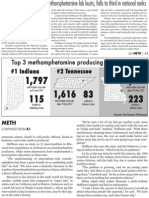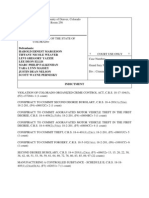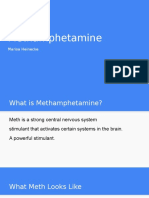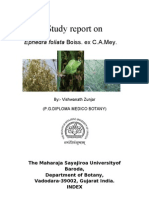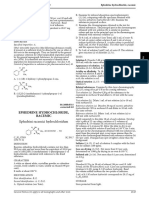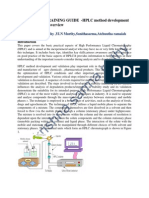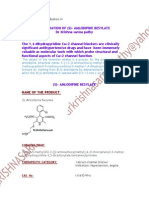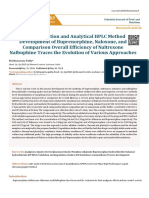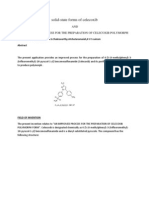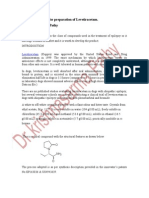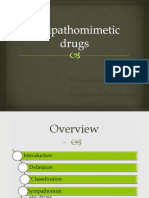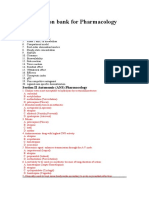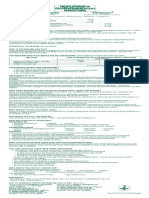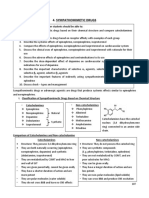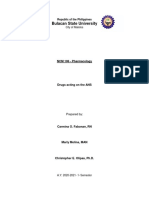Improved Process For Preparing L-Phenylephrine Hydrochloride On An Industrial Scale
Improved Process For Preparing L-Phenylephrine Hydrochloride On An Industrial Scale
Uploaded by
Drkrishnasarma pathyCopyright:
Available Formats
Improved Process For Preparing L-Phenylephrine Hydrochloride On An Industrial Scale
Improved Process For Preparing L-Phenylephrine Hydrochloride On An Industrial Scale
Uploaded by
Drkrishnasarma pathyOriginal Title
Copyright
Available Formats
Share this document
Did you find this document useful?
Is this content inappropriate?
Copyright:
Available Formats
Improved Process For Preparing L-Phenylephrine Hydrochloride On An Industrial Scale
Improved Process For Preparing L-Phenylephrine Hydrochloride On An Industrial Scale
Uploaded by
Drkrishnasarma pathyCopyright:
Available Formats
25-5-2005
Dr.Krishnasarma.Pathy
Improved process for preparing L-phenylephrine hydrochloride on an industrial scale ABSTRACT The present invention relates to an improved process for preparing L-phenylephrine hydrochloride on an industrial scale Dr .Krishna Sarma Pathy Prof. P,Atchutaramaiah. ANDHRAUNIVERSITY INTRODUCTION Phenylephrine hydrochloride is an oral sympathomimetic amine that acts as a decongestant to respiratory tract mucous membranes. While its vasoconstrictor action is similar to that of ephedrine, phenylephrine has less pressor effect in normotensive adults. Serum half-life for phenylephrine is 6 to 8 hours. Acidic urine is associated with faster elimination of the drug. About one-half of the administered dose is excreted in the urine. Meta hydroxyl acetophenone is reacted with bromine in ethyl acetate to get the bromo compound which is reacted with N-methyl benzyl amine to obtain 2-(benzyl methyl amino) - 1-(3-hydroxy phenyl) ethanone. 2-(benzyl methyl amino) - 1-(3-hydroxy phenyl) ethanone.is hydrogenated under high pressure using palladium carbon catalyst to get DL- phenylephrine base. DL- phenylephrine base is reacted with L- tartaric acid to isolate L-phenylephrine base. L-phenylephrine base is converted to the hydrochloride salt by treatment with IPA HCl.
PHENYL EPHRINE HYDROCHLORIDE
Br Br
Bromine
Br
O HO HO
Meta Hydroxy acetophenone C8H8O2 Mol. Wt.: 136.15
2-Bromo-1-(3-hydroxy-phenyl)-ethanone C8H7BrO2 Mol. Wt.: 215.04
NH
n methyl Benzyl amine C8H11N Mol. Wt.: 121.18 10% PD/C
HO OH NH HO O N
3-(1-Hydroxy-2-methylamino-ethyl)-phenol C9H13NO2 Mol. Wt.: 167.21
OH HO OH O OH O
2-(Benzyl-methyl-amino)-1-(3-hydroxy-phenyl)-ethanone C16H17NO2 Mol. Wt.: 255.31
L(+) Tartaric acid
OH
H HO
H N HO
OH
H N Cl H
HCL 3-(1-Hydroxy-2-methylamino-ethyl)-phenol C9H13NO2 Mol. Wt.: 167.21
3-(1-Hydroxy-2-methylamino-ethyl)-phenol hydrochloride PHENYL EPHRINE HYDROCHLORIDE C9H14ClNO2 Mol. Wt.: 203.67
25-5-2005
Dr.Krishnasarma.Pathy
Ephedrine exhibits optical isomerism and has two chiral centres, giving rise to four stereoisomers. By convention the enantiomers with opposite stereochemistry around the chiral centres (1R, 2S and 1S, 2R) are designated ephedrine, while pseudoephedrine has same stereochemistry around the chiral carbons (1R, 2R and 1S, 2S). STAGE-1: Preparation of 2-(Benzoyl methyl Amino)-1-(3-Hydroxy phenyl) ethanone from Meta hydroxyl acetophenone in presence of bromine & n-Methyl benzyl amine. Arrange a 4 necked RBF with a mechanical stirrer, powder funnel with condenser, thermometer pocket & thermometer. Charge 3-Hydroxy acetophenone in ethyl acetate (525ml) in RBF at 30-35C.Start chilling and add Aluminum chloride .Meanwhile charge ethyl acetate in conical flask with chilling and add bromine, mix well(Slight exothermic reaction).Start the addition of bromine solution. After the addition of 70% bromine solution reaction mass becomes a clear solution After the addition, maintain the reaction mass for 2 hrs.After the maintenance, raise the temperature to 10C.Then charge toluene (1285ml).Charge (1200ml) water to the reaction mass. Keep it stirring for 30 mins & separate the layers. Wash the aqueous layer with (345ml) toluene. Both the toluene layers are collected. Wash the toluene layer with (900ml) 2% sodium bicarbonate solution. Wash the toluene layer with (600ml) D.M. water. Repeat the step twice. Collect the toluene layer in conical flask & add sodium sulphate Take the toluene layer in RBF & chill to 0C.Start the addition of n- Methyl Benzyl amine & maintain the reaction mass for 2 hrs at 0-5C.Filter the reaction mass & wash with toluene(200ml) Wet cake: 285gm Collect the mother liquor in RBF & start the addition of IPA-HCl solution Heat the reaction mass to 50-55C & maintain for 1 hr Cool the reaction mass to RT Then chill the reaction mass to 0-2C & maintain for 1 hr Filter the product & wash with chilled (200ml) toluene & (200ml) chilled ethyl acetate RESULTS: 1) Wet weight of the compound: 900gm 2) Dry weight of the compound: 507gm 3) Melting point: 180-189C STAGE-2: Preparation of 3-(1-hydroxy-2-methyl amino ethyl) phenol. 1) 2) 3) 4) 5) 6) Stage-1 product: 1000gm Methanol: 6 lit Palladium 10% : 125gm Carbon: 10gm Liquid Ammonia: 1080ml D.M.water: 1700ml
25-5-2005
Dr.Krishnasarma.Pathy
Arrange a 4 necked RBF with a mechanical stirrer, powder funnel with condenser, thermometer pocket & thermometer. Charge 1kg stage-1 product in RBF and add 5 lit fresh methanol and start heating. Reflux the reaction mass. Add 10gm carbon & stir for 30 min at reflux temperature Filter the reaction mass by hyflo bed & wash with 1 lit methanol. Collect the mother liquor Further hydrogenation step is carried out .The hydrogenated mother liquor is then distilled out under vacuum. After completion of distillation, the reaction mass was cooled to 40C, stir for 1 hr Add 1500ml D.M water & cool to RT, stir for 1 hr .Start the addition of liquid ammonia & maintain the pH at 9.5-9.7.After the addition, add seeding material (2.0gm) & maintain for 6 hrs at RT Then start chilling the reaction mass & maintenance is started. Filter the reaction mass & wash with (200ml) chilled D.M. water. 1) Wet weight of the compound: 610gm 2) Dry weight of the compound: 350gm STAGE-3A: Preparation of 3-(1-Hydroxy -2- Methyl Amino Ethyl) Phenol. 1) Stage-2product: 300gm 2) Isopropyl Alcohol (IPA): 750ml 3) L(+) Tartaric acid : 300gm 4) Liquid Ammonia: 500ml 5) D.M. water:1350ml Arrange a 4 necked RBF with a mechanical stirrer, powder funnel with condenser, thermometer pocket & thermometer. Charge IPA in RBF under stirring add (300gm) stage 2 product .Then charge L+ tartaric acid & heat up to 55-60C.Then maintain the reaction mass for 1 hr .After the maintenance, cool the reaction mass to RT. Charge the seeding material & cool the mixture to RT .Maintain the mixture at RT for 12hrs.Filter the reaction mass & wash with (100ml) IPA 15%.Collect the mother liquor & adjust the pH to 9.5-9.7 with Liquid ammonia, stir for 30 mins .Cool the mixture to 0-5C, stir for 3 hrs at 05C.Filter the reaction mass & wash with IPA (150ml).Then charge D.M. water (750ml) Heat the reaction mass to 65-70C.Stir the mixture for 1 hr Cool the reaction mass to RT. Cool the mixture to 0C, stir for 2 hrs at 0-5C Filter the product & wash with chilled D.M. water (600ml) Dry the wet cake at 50-55C RESULTS: 1) Wet weight of the compound: 158gm 2) Dry weight of the compound: 86gm 3) Melting point: 168-172C 4) Appearance: Light brown coloured powder 5) % yield: 0.285%
25-5-2005
Dr.Krishnasarma.Pathy
STAGE-3B: AIM: Recovery of 3-(1-Hydroxy -2- Methyl Amino Ethyl) Phenol from salt. REQUIREMENTS: 1) Stage-3 A product: 276gm 2) Carbon : 10gm 3) Liquid Ammonia: 300ml 4) D.M. water:600ml Arrange a 4 necked RBF with a mechanical stirrer, powder funnel with condenser, thermometer pocket & thermometer Charge (600ml) D.M. water in RBF under stirring add (276gm) stage-3A product Heat the reaction mass to 60C & then charge (10gm) carbon. Maintain the reaction mass for 1 hr at 60-65C.Filter the reaction mass under hyflo bed & collect the mother liquor. Adjust the pH to 9.09.5 with liquid Ammonia. Maintain it for 30 mins at 60C.Cool the mixture to RT. Filter and wash with (200ml) D.M. water.(Repeat the step twice)Charge (438ml) Acetic Anhydride in RBF & add (76gm) salt obtained above slowly.(88gm) Sulphuric acid is added slowly in 2 hrs .Maintain for 1 hr at RT .Heat the mixture to 100-105C.Maintainat 100-105C for 1 hr .Cool the mixture to 80C.Completely distill out Acetic Anhydride under vacuum at 80C.Cool to 40C.Slowly add (135ml) D.M water .Heat the reaction mass to 85C.Maintain the mixture for 3 hrs at 80-85C.Then cool to 40C.Slowly add Liquid Ammonia (21ml) .Distill out D.M. water completely under vacuum. Charge (279ml) D.M.water slowly. Heat to 85C.Maintain the mixture for 3 hrs at 80-85C.Cool the mixture to 40C.Start the addition of liquid ammonia (39ml) .Distill out water completely under vacuum. Cool the mixture to 40C.Charge (555ml) D.M water slowly. Heat the reaction mass to 85C.Maintain the mixture for 3 hrs at 80-85C.Cool the mixture to 40C.Adjust the pH to 9-9.5 with liquid Ammonia. Stir for 30 mins. Filter and wash with (300ml) D.M water. Charge (250ml) IPA (10% moisture content) into an RBF and charge the above dried material. Heat the mixture to reflux temperature and maintain at this temperature for 1 hr. Cool the mixture to RT .Wash the product with (35ml) IPA (10% moisture content) Dry the product RESULTS: 1) Wet weight of the compound: 65gm 2) Dry weight of the compound: 50.5gm Melting point: 169C -172C STAGE-4: Preparation of 3-(1-Hydroxy -2- Methyl Amino Ethyl) Phenol Hydrochloride i.e., Phenylephrine hydrochloride. REQUIREMENTS: 1) Stage-3B product: 61gm 2) Methanol: 900ml 3) Carbon: 12gm 4) Acetone: 150ml 5) IPA -HCl: 140ml Arrange a 4 necked RBF with a mechanical stirrer, powder funnel with condenser, thermometer pocket & thermometer. Charge (900ml) methanol in RBF under stirring add (61gm) stage-3B product .Then charge charcoal & stir for 30 mins .Filter the reaction mass through hyflow bed & wash with (50ml) methanol & collect the mother liquor. Again add charcoal (5gm), stir for 30 mins under stirring.Filter the reaction mass through hyflo bed & wash with (100ml) methanol & collect the mother liquor.Charge IPA HCl under stirring.Complete the addition.Stir the reaction mass for 30 mins.Distill out methanol under vacuum.Add (150ml) Acetone & stir for 1 hr at RT .Chill the reaction mass to 10-15C & maintain for 1 hr.Filter the product & wash with (50ml) Acetone 3)
25-5-2005 RESULTS: 1) Wet weight of the compound: 69gm 2) Dry weight of the compound: 65gm 3) Melting point: 143-145C 4) Optical rotation : -43.79 5) % yield: 1.06% 6) Purity by HPLC: 99.45% 7) Appearance: Almost white powder
Dr.Krishnasarma.Pathy
Ref: H. Legerlotz, US 1932347 (1933 to Frederick Stearns); E. D. Bergmann, M. Sulzbacher, J. Org. Chem. 16, 84 (1951); M. K. Gurjar et al., Org. Process Res. Dev. 2, 422 (1998). Spectrophotometric determn: S. A. Shama, J. Pharm. Biomed. Anal. 30, 1385 (2002). Toxicity data: M. R. Warren, H. W. Werner, J. Pharmacol. Exp. Ther. 86, 284 (1946). Clinical efficacy in mydriasis: V. Tanner, A. G. Casswell, Eye 10, 95 (1996). Clinical evaluation in fecal incontinence: M. J. Cheetham et al., Gut 48, 356 (2001). Comprehensive description: C. A. Gaglia, Jr., Anal. Profiles Drug Subs. 3, 483-512 (1974). Review of ophthalmologic uses: S. M. Meyer, F. T. Fraunfelder, Ophthalmology 87, 1177-1180 (1980); of clinical trials vs ephedrine, q.v., in treatment of hypotension during cesarean delivery: A. Lee et al., Anesth. Analg. 94, 920-926 (2002).
You might also like
- Excerpt: "It Worked For Me" by Colin PowellDocument2 pagesExcerpt: "It Worked For Me" by Colin Powellwamu885No ratings yet
- Codeine DesomorphineDocument10 pagesCodeine DesomorphineHadiyanto Tiono100% (1)
- Chapter 11. Colds and AllergyDocument22 pagesChapter 11. Colds and AllergyMonica CiorneiNo ratings yet
- 4Th Year Organic Chemistry Lab ManualDocument8 pages4Th Year Organic Chemistry Lab ManualsivabioteckNo ratings yet
- Synthesis of Lidocaine: Chemistry 212 LaboratoryDocument4 pagesSynthesis of Lidocaine: Chemistry 212 LaboratoryNuteLLa Gaming (EFL)No ratings yet
- Reduction Reactions: N-Oxides Sulphoxides S-S C-CDocument41 pagesReduction Reactions: N-Oxides Sulphoxides S-S C-CEmad MustafaNo ratings yet
- L Pac - Partially.purified - Pyruvate.decarboxylaseDocument11 pagesL Pac - Partially.purified - Pyruvate.decarboxylasePaul Yourweiht100% (1)
- Mephedrone Research Paper1Document6 pagesMephedrone Research Paper1api-272831841No ratings yet
- Opium and Its DerivativesDocument40 pagesOpium and Its DerivativesAswin KennedyNo ratings yet
- Biblio MethDocument103 pagesBiblio MethRichard DodsonNo ratings yet
- Anne Bülow - Combinatorial Synthesis of Cocaine AnaloguesDocument126 pagesAnne Bülow - Combinatorial Synthesis of Cocaine AnaloguesPoloGreenNo ratings yet
- United States Court of Appeals, First CircuitDocument10 pagesUnited States Court of Appeals, First CircuitScribd Government DocsNo ratings yet
- Applications OF Analytical Chemistry in Forensics: Maimoona Saeed PCHEM01193002 Semester 2Document7 pagesApplications OF Analytical Chemistry in Forensics: Maimoona Saeed PCHEM01193002 Semester 2Ujala AsadNo ratings yet
- Ashley Lemke v. Soap Korner LLCDocument14 pagesAshley Lemke v. Soap Korner LLCMichael_Lee_RobertsNo ratings yet
- Make CocaineDocument19 pagesMake CocaineRahul WaskelNo ratings yet
- ElectroDocument17 pagesElectroRyan WalkerNo ratings yet
- MethamphetamineDocument2 pagesMethamphetamineMax KraussNo ratings yet
- OrganicDocument35 pagesOrganicKristina CoeNo ratings yet
- MethDocument2 pagesMethBrandon ZennerNo ratings yet
- Synthesis of MDMA - ThesisDocument104 pagesSynthesis of MDMA - ThesisArsenioDeOliveira100% (1)
- Catalog Tryptamine Derivatives January 16th 2018Document8 pagesCatalog Tryptamine Derivatives January 16th 2018LucSwissNo ratings yet
- Universal Extraction Technique - Straight To BeeDocument7 pagesUniversal Extraction Technique - Straight To BeeMatt CarterNo ratings yet
- Buy 4-HO-MIPT, 5-MEO-MIPT and Pro Lad OnlineDocument2 pagesBuy 4-HO-MIPT, 5-MEO-MIPT and Pro Lad Onlinetravis Henne100% (2)
- The History of EcstasyDocument24 pagesThe History of Ecstasyshakahs204386% (7)
- 2009 Patterns and Trends of Amphetamine-Type Stimulants and Other Drugs in East and South-East AsiaDocument152 pages2009 Patterns and Trends of Amphetamine-Type Stimulants and Other Drugs in East and South-East AsiaPugh JuttaNo ratings yet
- Extraction and Purification of Natural Products PDFDocument9 pagesExtraction and Purification of Natural Products PDFharishkumar kakraniNo ratings yet
- University of Management And: Ms BiochemistryDocument17 pagesUniversity of Management And: Ms BiochemistryZain KhalidNo ratings yet
- Tiffany Nicole Weaver, Et. Al, Auto Theft Ring IndictmentDocument64 pagesTiffany Nicole Weaver, Et. Al, Auto Theft Ring IndictmentMichael RobertsNo ratings yet
- 4.7 Ethylphenidate CritReviewDocument19 pages4.7 Ethylphenidate CritReviewkevinNo ratings yet
- Synthetic Cannabinoids - Epidemiology, Pharmacodynamics, and Clinical Implications Nihms-2014Document61 pagesSynthetic Cannabinoids - Epidemiology, Pharmacodynamics, and Clinical Implications Nihms-2014smk0602No ratings yet
- FermentationDocument48 pagesFermentationMaria Jezza LagradaNo ratings yet
- HCL Gnereator Clandestine5Document39 pagesHCL Gnereator Clandestine5Richard PortillooNo ratings yet
- %Lrwudqvirupdwlrqri%Hq) Doghk/Ghwr/3Khq/Odfhw/Ofduelqro /3$&E/) Uhh&Hoovri7Ruxodvsrud Ghoeuxhfnll Lqsuhvhqfh Ri%Hwd&/Forgh (WulqDocument4 pages%Lrwudqvirupdwlrqri%Hq) Doghk/Ghwr/3Khq/Odfhw/Ofduelqro /3$&E/) Uhh&Hoovri7Ruxodvsrud Ghoeuxhfnll Lqsuhvhqfh Ri%Hwd&/Forgh (WulqZane Van GreunenNo ratings yet
- EphedraDocument475 pagesEphedraJana Štěpánková HejzlarováNo ratings yet
- Toxics: Drug Vaping: From The Dangers of Misuse To New Therapeutic DevicesDocument16 pagesToxics: Drug Vaping: From The Dangers of Misuse To New Therapeutic DevicesevanNo ratings yet
- The Truth About LSD: By: Jason Nichols Christy Kelly RamirezDocument17 pagesThe Truth About LSD: By: Jason Nichols Christy Kelly RamirezJason NicholsNo ratings yet
- MdmaDocument55 pagesMdmaSonnie DepresionNo ratings yet
- TSD Ammonia Meth Labs 10-8-03Document11 pagesTSD Ammonia Meth Labs 10-8-03Mul YaniNo ratings yet
- MethamphetamineDocument15 pagesMethamphetamineapi-341003603No ratings yet
- Ephedra FoliataDocument16 pagesEphedra Foliatavishwanathz47No ratings yet
- Recreational Drug Discovery: Natural Products As Lead Structures For The Synthesis of Smart DrugsDocument26 pagesRecreational Drug Discovery: Natural Products As Lead Structures For The Synthesis of Smart DrugsStiven DestNo ratings yet
- House Hearing, 109TH Congress - Comprehensively Combating Methamphetamines: Impacts On Health and The EnvironmentDocument85 pagesHouse Hearing, 109TH Congress - Comprehensively Combating Methamphetamines: Impacts On Health and The EnvironmentScribd Government DocsNo ratings yet
- Methylamine From Hmta2Document7 pagesMethylamine From Hmta2jiskate77No ratings yet
- AmphetaminesDocument39 pagesAmphetaminesRonie Alvarez MaldonadoNo ratings yet
- Ephedrine Hydrochloride, RacemicDocument1 pageEphedrine Hydrochloride, RacemicMulayam Singh YadavNo ratings yet
- Mastro Buon IDocument58 pagesMastro Buon IMagikFungusNo ratings yet
- Erowid Org Archive Rhodium Chemistry Meth Workup HTMLDocument9 pagesErowid Org Archive Rhodium Chemistry Meth Workup HTMLAdriatic PerceptionNo ratings yet
- Benzyl Methyl KetoneDocument3 pagesBenzyl Methyl KetoneBHAGWATI ENTERPRISENo ratings yet
- Flyer On Synthetic Cannabinoids PDFDocument2 pagesFlyer On Synthetic Cannabinoids PDFYianni ZaxNo ratings yet
- (Drugs) Future Drugs-ShulginDocument23 pages(Drugs) Future Drugs-Shulginberarpaul100% (1)
- EP1828105B1Document23 pagesEP1828105B1sunil_vaman_joshiNo ratings yet
- Re CrystallizationDocument7 pagesRe CrystallizationAli Nasrallah100% (1)
- PreparationDocument30 pagesPreparationqmh67708No ratings yet
- DEIPA - CN102924301A - Preparation Method of N, N-Bis (2-Hydroxuethyl) IsopropanolamineDocument5 pagesDEIPA - CN102924301A - Preparation Method of N, N-Bis (2-Hydroxuethyl) IsopropanolamineListya Eka AnggrainiNo ratings yet
- 435 ExperimentalDocument21 pages435 ExperimentalYun NikNo ratings yet
- Process of para Hydroxy Phenyl AcetamideDocument1 pageProcess of para Hydroxy Phenyl AcetamideBhargav PatelNo ratings yet
- Section-B: A Practical Book of Medicinal Chemistry-I (Sem. - V)Document19 pagesSection-B: A Practical Book of Medicinal Chemistry-I (Sem. - V)Raju NiraulaNo ratings yet
- Omcij MS Id 555853Document10 pagesOmcij MS Id 555853Drkrishnasarma pathyNo ratings yet
- Chronic Hepatitis (CHC), Viral Polymerase Nucleotide Inhibitor & Process Patents Review and Evaluation, Preparation of SofosbuvirDocument6 pagesChronic Hepatitis (CHC), Viral Polymerase Nucleotide Inhibitor & Process Patents Review and Evaluation, Preparation of SofosbuvirDrkrishnasarma pathyNo ratings yet
- Process and Molecular Modelling Study of Entecavir Drug-Resistant HBVDocument9 pagesProcess and Molecular Modelling Study of Entecavir Drug-Resistant HBVDrkrishnasarma pathyNo ratings yet
- Antiviral Nucleosides-Flu Viruses-Quinolines-COVID-19: Corresponding AuthorDocument12 pagesAntiviral Nucleosides-Flu Viruses-Quinolines-COVID-19: Corresponding AuthorDrkrishnasarma pathyNo ratings yet
- BJSTR Ms Id 001662considerationsDocument4 pagesBJSTR Ms Id 001662considerationsDrkrishnasarma pathyNo ratings yet
- Entecavir Patent Evaluation, Method For Diastereomeric Impurities OMCIJ - MS.ID.555711Document16 pagesEntecavir Patent Evaluation, Method For Diastereomeric Impurities OMCIJ - MS.ID.555711Drkrishnasarma pathyNo ratings yet
- Preparation of Vitamin C and Method For Determination of Vitamin C in Tablets SCSOAJ - ms.ID.000114Document14 pagesPreparation of Vitamin C and Method For Determination of Vitamin C in Tablets SCSOAJ - ms.ID.000114Drkrishnasarma pathyNo ratings yet
- BASIC SKILLS TRAINING GUIDE - HPLC Method Development and Validation - An Overview-1Document41 pagesBASIC SKILLS TRAINING GUIDE - HPLC Method Development and Validation - An Overview-1Drkrishnasarma pathy100% (1)
- S - Amlo BesylateDocument20 pagesS - Amlo BesylateDrkrishnasarma pathyNo ratings yet
- Medical Research and Clinical Case ReportsDocument5 pagesMedical Research and Clinical Case ReportsDrkrishnasarma pathyNo ratings yet
- Method Development and Pharmacological Study of Chemotherapeutic Agents OAJT - ms.ID.555568 DrkrishnasarmapathyDocument1 pageMethod Development and Pharmacological Study of Chemotherapeutic Agents OAJT - ms.ID.555568 DrkrishnasarmapathyDrkrishnasarma pathyNo ratings yet
- Industrial process for OXICONAZOLE Dr krishnasarma Pathy step-I 2,2’4’-tri-choloroacetophenone,Imidazole reacted in presence of acetonitrile to form 1-(2,4-dichlorophenacyl)-imidazole (I).Which is then reacted with hydroxylamine. hydrochloride to give (Z)-1-(2,4-dichlorophenyl)-2-(1H-imidazol-1-yl) ethanone oxime (II). It is further reacted with 2,4-Dichlorobenzyl chloride in presence of sodium hydride to give (III) Oxiconazole and finally salt formation with nitric acidDocument10 pagesIndustrial process for OXICONAZOLE Dr krishnasarma Pathy step-I 2,2’4’-tri-choloroacetophenone,Imidazole reacted in presence of acetonitrile to form 1-(2,4-dichlorophenacyl)-imidazole (I).Which is then reacted with hydroxylamine. hydrochloride to give (Z)-1-(2,4-dichlorophenyl)-2-(1H-imidazol-1-yl) ethanone oxime (II). It is further reacted with 2,4-Dichlorobenzyl chloride in presence of sodium hydride to give (III) Oxiconazole and finally salt formation with nitric acidDrkrishnasarma pathy100% (1)
- Route Evaluation and Analytical HPLC Method Development of Buprenorphine, Naloxone, and Comparison OverallSJFN - ms.ID.000105Document19 pagesRoute Evaluation and Analytical HPLC Method Development of Buprenorphine, Naloxone, and Comparison OverallSJFN - ms.ID.000105Drkrishnasarma pathyNo ratings yet
- Solid-State Forms of Celecoxib and An Improved Process For The Preparation of Celecoxib PolymorphDocument10 pagesSolid-State Forms of Celecoxib and An Improved Process For The Preparation of Celecoxib PolymorphDrkrishnasarma pathyNo ratings yet
- Industrial Process For Preparation of Levetiracetam.Document9 pagesIndustrial Process For Preparation of Levetiracetam.Drkrishnasarma pathy100% (4)
- MIDODRINEDocument6 pagesMIDODRINEMuhamad RizauddinNo ratings yet
- Ephedrine Hydrochloride: Ephedrine Hydrochloride 30mg Per 1ml Solution For InjectionDocument2 pagesEphedrine Hydrochloride: Ephedrine Hydrochloride 30mg Per 1ml Solution For InjectionAnonymous Au0vHUNo ratings yet
- Ephedrine & Phenylephrine 2Document27 pagesEphedrine & Phenylephrine 2Sabrina ShalhoutNo ratings yet
- Cough, Cold, and Allergy: AntitussivesDocument8 pagesCough, Cold, and Allergy: AntitussivesSalsabila RaniahNo ratings yet
- Sinarest SyrupDocument9 pagesSinarest SyrupYidiv VidiyNo ratings yet
- SympathomimeticDocument56 pagesSympathomimeticvarish0% (1)
- British Journal of Pharmacology and Chemotherapy - February 1966 - SHANKS - THE EFFECT OF PROPRANOLOL ON THE CARDIOVASCULARDocument12 pagesBritish Journal of Pharmacology and Chemotherapy - February 1966 - SHANKS - THE EFFECT OF PROPRANOLOL ON THE CARDIOVASCULARNeethi MNo ratings yet
- A Drug Study On: PhenylephrineDocument6 pagesA Drug Study On: PhenylephrineAlexandrea MayNo ratings yet
- Medicine Cabinet ApplicationDocument30 pagesMedicine Cabinet ApplicationSara FaiNo ratings yet
- Question Bank For Pharmacology - WJP AnsweredDocument55 pagesQuestion Bank For Pharmacology - WJP AnsweredGeorge MoshiNo ratings yet
- Adrenergic & Antiadrenergic DrugsDocument54 pagesAdrenergic & Antiadrenergic DrugsUzma KhanNo ratings yet
- ICU One Pager VasopressorsDocument1 pageICU One Pager VasopressorsSabina BaidooNo ratings yet
- Respiratory System DrugsDocument64 pagesRespiratory System DrugsArlyn MendenillaNo ratings yet
- Paracetamol Phenylephrine HCL Chlorpheniramine Maleate Caffeine Tablets - COL COL - Saga LaboratoriesDocument6 pagesParacetamol Phenylephrine HCL Chlorpheniramine Maleate Caffeine Tablets - COL COL - Saga LaboratoriesAbdulkadir JemalNo ratings yet
- Sinarest LPDocument3 pagesSinarest LPJohn StanleyNo ratings yet
- Dry CoughDocument3 pagesDry Coughnevismn3498No ratings yet
- FINALSSSDocument31 pagesFINALSSSChristine UdhayNo ratings yet
- ICU One Pager Vasopressors.1.2Document1 pageICU One Pager Vasopressors.1.2Nguyễn Ngọc Quỳnh NhưNo ratings yet
- An Overview of Anti-Allergic Drug Therapy and The Histamine-1 AntihistaminesDocument7 pagesAn Overview of Anti-Allergic Drug Therapy and The Histamine-1 Antihistaminesalinamatei1000000No ratings yet
- Neozep Forte PDFDocument1 pageNeozep Forte PDFLimuel EspirituNo ratings yet
- 1 Pharmacy Practice Therapeutics OTC Drugs Q&A Content Ver1Document123 pages1 Pharmacy Practice Therapeutics OTC Drugs Q&A Content Ver1bhaveshnidhi64100% (1)
- Sympathomimetic Drugs PharmacologyDocument10 pagesSympathomimetic Drugs PharmacologyHaroon JavedNo ratings yet
- Drug CalculationDocument34 pagesDrug CalculationMalathi VarnaNo ratings yet
- Adrenergic NS 2Document43 pagesAdrenergic NS 2Abdullah Muhammed khaleel HassanNo ratings yet
- Hemostatic Gingival Retraction Agents and Their Impact On Prosthodontics Treatment Steps-A Narrative ReviewDocument14 pagesHemostatic Gingival Retraction Agents and Their Impact On Prosthodontics Treatment Steps-A Narrative ReviewCristobalVera100% (2)
- Allergic RhinitisDocument10 pagesAllergic Rhinitisanamuj8No ratings yet
- Unit 7 Drugs Acting On The ANSDocument18 pagesUnit 7 Drugs Acting On The ANSTherese Margarette SantiagoNo ratings yet
- Dissertation TopicDocument12 pagesDissertation TopicSaurav RexregisNo ratings yet
- 13 Priapism LRDocument11 pages13 Priapism LRKofi Frimpong-MansonNo ratings yet



















